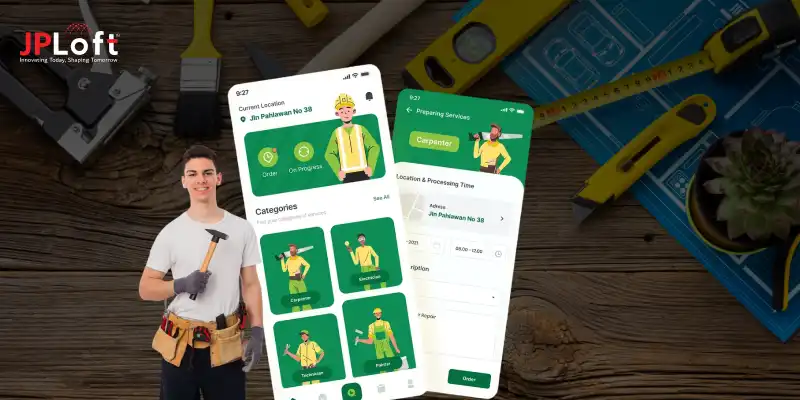“Quality is when the customer comes back, not the product”- Hermann Tietz
In this competitive world, you can win only when you know the crucial techniques to make your app different from the others and to reach the potential audience.
Well, when it comes to a service industry like Handyman, user experience comes first.
One of the major ways to build it is by creating an app that helps to address their issues and errors promptly, and the other is reducing the errors in its functionality and upgrading the app over time.
If you are an entrepreneur with an app and are bothered about how you can continuously lead the industry or remain a pioneer in the handyman industry, then “ Handyman App Testing “ is your answer.
In this blog, we will discuss it all from the concept of the handyman app, stats, reasons, areas, steps, and even the practices to conduct rigorous testing.
Are you ready to learn it all?
Yes! Then, let's proceed together.
Handyman App and Related Stats
A handyman app is designed for connecting users with local professionals for diversified home repair and maintenance tasks.
These handyman apps streamline the procedure of funding, booking, and paying for the crucial services such as electrical work, furniture assembly, plumbing, and more.
Let’s discover some crucial handyman app statistics in the given points.
-
- The handyman app market size was valued at USD 2.8 billion in the year 2024, which is projected to reach USD 5.2 billion by the year 2031, growing at a CAGR of 8%.
- In the year 2025, the global handyman service market is estimated to be valued at approximately. USD 530.5 million. By the year 2035, the revenue is expected to grow around USD 2,340.4 million, which reflects an annual growth rate of 16.0%.
- Assuming a 2025 market size of $5 billion and a conservative CAGR of 15% over the next decade, the market could reach approximately. $13 billion by the year 2033.
These stats are effective and can be defined as a reason to build a handyman app.
Now, when you look over the development processes, there are many steps that you should consider, such as design, technology stack, design, and testing.
Here, in this blog, let's learn all about testing.
Now, the question that might puzzle you can be “ what’s the need to test the handyman app?’
Let’s learn it all in the section below.
Why Test a Handyman App?
Whether it's a mobile app or a handyman app, testing plays an important role in this diversified world.
Through mobile app testing, you can reduce errors, build user trust, and much more. Let’s consider the reasons below.
1. Ensures Functionality
The handyman apps ensure functionality through streamlining the connection with the customers and even with the service providers.
Through testing an app, you can successfully boost the trust of the users and increase their interest in booking a service.
You can ensure seamless functionality through functional testing, which helps to improve the user experience and software quality as well as reliability.
With the help of testing, you can identify the bugs and errors early in the development process, preventing your app from escalating future issues that can increase the risk of app failure.
2. Testing Boost Security
If you want to secure the users from any data loss or cyber threats, then testing can be a helpful process to boost the overall security of the app.
Security testing is one of the potential aspects to ensure that software systems and networks enhance user trust and protect them.
Testing a handyman app can help identify vulnerabilities and weaknesses before deployment, which further helps in preventing data breaches, protecting sensitive data, and maintaining user trust.
Additionally, it helps in identifying any security threats that can be useful to the organisations to protect the sensitive user data from any kind of unauthorized access.
3. Improves Overall App Performance
If you want to build an app like Urban Company, it's essential to go for handyman app rigorous testing. Under this process, you can identify bugs and fix them by ensuring that individual components of your app work seamlessly.
App testing does help in ensuring smooth navigation, an intuitive user interface, along with the user experience.
The favorable reputation of the app depends on the app’s performance. It helps to avoid slow loading times of the apps and their features, and is helpful to prevent app crashes.
With the help of rigorous app testing, you can guarantee a smooth experience of the app, regardless of the mobile device’s specifications.
Are you ready to proceed with the handyman app testing process?
Well, the following section can be useful.
Which Areas to Test in a Handyman App?
The handyman app should be tested across several areas to ensure a smooth and reliable user experience. These areas comprise functionality, usability, performance, and security.
Can testing your customized handyman app rigorously increase the overall cost?
Well, it can be; however, you can ask the developers which specific areas require testing.
When you want to define the cost to build a handyman app, it's essential to explore diversified aspects, and testing is one of them.
Let’s discover the areas that require testing in the handyman apps.
1] Functional Testing
The functional testing in the handyman apps ensures that all core features, including messaging, booking, and payments, work as intended.
It is a type of software testing that verifies if the application functions according to the specified requirements.
This type of testing helps in identifying bugs early, improving the user experience, and enhancing the overall quality and reliability of the app.
It does focus on verifying that all the features as well as functionalities work as intended, to ensure a smooth user experience for both the customers and service providers.
2] Compatibility Testing
The compatibility testing in the handyman apps ensures that the app functions smoothly.
This type of testing helps to verify if a software application works successfully in diversified environments, comprises different systems, and more.
It ensures that the application functions as expected across the diversified platforms and with other software.
This helps in examining and comparing the functionality over multiple browsers, devices, platforms, and operating systems for recognizing the potential discrepancies.
3] Performance Testing
Performance testing is a software testing procedure that evaluates how a system behaves under specific workloads, focusing on its speed, stability, and scalability.
It is one of the types of software testing that helps to evaluate how well a system or application platform performs under a specific workload or set of conditions.
This type of testing focuses on diversified measuring aspects such as speed, scalability, and resource utilization rather than finding bugs or detecting defects.
4] Usability Testing
Usability testing is a method that is used for evaluating how easy and enjoyable a product, website, or app is to use, by observing the real users’ behaviour.
Through usability testing, you can identify design flaws, measure user satisfaction, and ensure that a product is intuitive and user-friendly.
It is one of the methods of evaluating the user experience, navigation of websites, apps, and digital products. Under this aspect, you should measure how easy it is to use a handyman app.
5] Security Testing
Security testing is one of the software types that focuses on identifying vulnerabilities and weaknesses in the systems’ security mechanisms.
The major aspect of the security testing is to evaluate the security of your app and protect it from any kind of cyber threat. It does help in identifying the system’s security controls, including encryption, authorization, and authentication.
Security testing is one of the important protocols that helps to uncover flaws and ensures that the data and resources remain protected.
6] Design
Here, you should check the handyman app design. The software testing and design are intrinsically linked. A complicated design requires an effective testing process.
It comprises feature verification, user interface testing, business logic testing, database interaction, and performance evaluation.
Here, it's important to test the usability of the app that dictates the scenarios and tasks used in usability testing. Additionally, the UI/UX design choices determine the accessibility standards that need to be tested thoroughly.
7] Other Important Areas to Test
Other areas that require a continuous testing process include push notification, GPS navigation, calendar booking, user profile management, social login, and multiple payment methods.
It's essential to evaluate the app store guidelines to ensure that the app complies with the defined standards of the industry.
Along with this, it's important to evaluate the unexpected input, error messages, and edge cases such as very long service descriptions or large numbers of bookings.
These were some of the crucial areas that you can consider while testing your handyman app.
Now, the question that arises is “how to test a handyman app?”
Let’s learn about the steps to test a handyman app below.
How to Test a Handyman App?
When you start with an online handyman business, it's essential that you are well aware of every step and how to practice it in detail.
Testing is one of them that you cannot avoid.
Let’s learn more about the steps to test a handyman app in the steps below.
Step 1: Creating a Strategy for Testing
The foremost step while testing a handyman app can be exploring the need for testing, then building a thorough strategy for the one.
Under this step, all you need to do is select the right mobile devices and tools to test your app in this competitive environment.
Here, you can finalize the areas of testing when it comes to handyman apps. Along with defining the team of developers who can help you test the app.
Step 2: Building an Environment for Testing
Now, you should evaluate the environment and identify whether the environment is suitable for your handyman app or not.
Here, all you need to do is carefully plan the testing for your handyman app, configure all the essential components of the testing process, and talk to the experts.
Testing the app should consist of all the essential components, so that a robust testing process can be conducted.
Step 3: Select the Right Testing Tools
Identifying the right testing tools can be helpful for first identifying the specific testing needs of the app, then it's essential to evaluate the tools based on different factors such as features, compatibility, and cost.
Later, you can proceed with testing with a few options prior to making a final decision.
Here, the tools that you can further include are Appium, Espresso, and BrowserStack, which are useful for automating the testing procedure across diversified platforms and services.
Apart from the above, you should go with the testing tools like BrowserStack, Espresso, Cypress, SoapUI, and Katalon Studio.
Step 4: Test Case Design and Execution
It's crucial to test the app and proceed with the step-by-step testing procedure.
This is one of the crucial parameters where all you need to do is define the complete structure, on which you can verify the functionality and behavior of the user.
You can go for the vulnerability detection in the handyman app testing; that’s all about security testing and including the normal, abnormal, and error conditions.
Along with this, it's essential here to prioritize the test cases through critical ensure the most important functions are tested first.
Step 5: Defect Management
After executing the thorough testing procedure for your handyman app, it's time to closely identify the defect, reach its core, and then manage the systematic process for identifying, analyzing, and even resolving the core defects and issues during the testing process.
During defect management, all you can do is prioritize the tasks and relative functions for tracking, performing verification, and resolving them.
Here, the developers can fix the defects in the app after prioritizing the cases, tracking the status of the app, and building resolution strategies for the same.
Step 6: Test Closure
Now, as the complete handyman app testing process is completed and evaluated, it's time to close the test.
It is to be noted that testing the app can enhance the downtime for your app if it's already been launched in the competitive market.
However, with the help of effective tools and connecting with capable developers, you can reduce this downtime and resolve the errors wisely.
These were some of the crucial and fruitful steps to consider when it comes to testing a handyman app.
Well, in this handyman app testing guide, we have tried to mention all the details. Now, let's look ahead to the various types of tools you can use for testing the handyman app in the section below.
Tools for Handyman App Testing
Without learning about the crucial tools and techniques for your handyman app, you cannot proceed with the complete process, right?
Wait, we have evaluated all the testing tools crucial to include while testing your app thoroughly.
Let’s cover them all in the table below.
|
Category of Tool |
Purpose |
Examples (Popular Choices) |
|
Test Management |
Organize test cases, plans, and execution. |
Jira (with plugins), TestRail, Azure DevOps Test Plans |
|
Bug Tracking |
Report, track, and manage software defects. |
Jira, Asana, Bugzilla, Trello |
|
Functional/UI Automation |
Automate repetitive UI interactions & checks. |
Appium (Cross-platform), Espresso (Android), XCUITest (iOS) |
|
Cloud Device Labs |
Test on a wide range of real devices/OS versions. |
BrowserStack, LambdaTest, Sauce Labs, Kobiton |
|
Performance Testing |
Evaluate app speed, responsiveness, and stability under load. |
Apache JMeter, BlazeMeter, NeoLoad, Apptim (mobile-focused) |
|
Security Testing |
Identify vulnerabilities and security flaws. |
OWASP ZAP, Burp Suite, MobSF, NowSecure |
|
Usability Testing |
Gather user feedback on ease-of-use. |
UserTesting, Lookback, Maze, Userlytics |
|
API Testing |
Test the app's backend and data communication. |
Postman, SoapUI, Katalon Studio |
|
Crash Reporting |
Monitor crashes and errors in real-time. |
Firebase Crashlytics, Sentry, Instabug, BugSnag |
Well, now let’s look over what the topmost handyman apps do when it comes to testing, in the section below.
Case Study: How Leading Handyman Apps Pursue the Testing Process
When you know what the competitors are doing in the industry, it can help you sustain the competition. Along with this, it can motivate you to proceed with an effective testing procedure.
Now, let’s find out more about the top Handyman apps and their testing methods below.
Case Study 1: Handy
Handy is one of the leading apps in the industry, which performs a regular testing process. Here, the app uses diversified techniques and tools that help the app to sustain the environment.
This platform focuses on thorough testing, vetting, and screening of its platforms rather than relying heavily on traditional software testing methods. You can evaluate the cost to develop an app like Handy after evaluating the diversified strategies that it follows.
Case Study 2: Thumbtack
Thumbtack is a platform that connects homeowners and customers effectively. It does provide the tools to manage the accounts for the users, which helps them to book a service effectively.
You can build a platform like Thumbtack only after examining the key strategies and factors impacting the same.
Case Study 3: TaskRabit
TaskRabit is one of the apps that helps to connect individuals needing help with various tasks with the local, vetted service providers. The app uses the latest and advanced tools when it comes to app testing.
You can analyze the cost to develop an app like TaskRabbit after analyzing diversified factors impacting the cost.
These were all the case studies to go through when it comes to testing a handyman app. Now, let's discover some of the key challenges in the section below.
Challenges in Handyman app testing
When you begin to build your customized app, it's essential to test, and in this process, you might face crucial challenges.
Let’s explore the key challenges below.
-
Device Fragmentation
If the device does not support your testing process or if it lacks device compatibility, then it can be a crucial challenge for the handyman app testing process. Additionally, testing without considering the screen sizes or hardware configuration can be a challenge.
-
Location Service and Map Integration
Through location service and map integration, a challenge can be created due to the need for accurate real-time tracking, handling the user behavior, as well as ensuring data privacy and security of the handyman app testing.
-
Lack of a Prominent Testing Tool
A lack of a prominent testing tool specifically tailored for the handyman apps, which can indeed present a challenge during conducting an in-depth testing process, impacting efficiency and the quality of the user experience.
-
Testing Without Purpose
If the purpose of your testing app is not clear, then it can lead to a challenge for your app. Lack of purpose can impact the overall performance of your app in the long run. Thus, it is one of the important challenges where the lack of focus can lead to wasted time and resources.
Now, let’s look towards the practices that you can adopt to mitigate the above-listed challenges in the given section.
Effective Practices to Test a Handyman App
Undoubtedly, testing is one of the important steps when it comes to handyman app maintenance.
However, without learning about the effective practices, it's of no use. Hence, let’s learn the crucial practices beneath.
► Define a Clear Purpose
You should clearly state the purpose of the handyman app before you check out the steps.
Here, you should focus on ensuring that the app effectively connects customers with reliable handymen, which helps to provide the user with a seamless experience.
► Identify the Testing Areas
One of the practices to adopt is identifying the key areas in the testing process. It's crucial to establish the core testing measures, objectives for determining the scope and boundaries for your handyman app functionality.
Along with this, you can proceed to set a metric for defining a measure of how much a software application has been successfully tested.
► Conduct Various Kinds of Testing
Based on the areas of your handyman app, you can proceed with the different kinds of testing. Here, you can go with the functionality testing, such as core testing, the booking system, and payment gateway integration.
All you can do here is conduct usability testing, security testing, evaluate the speed and responsiveness of the app, along with stress testing.
► Collaborate and Communicate
Now, it's time to collaborate with the potential developers, who can help you win the environment and can help you enhance the value of your app in this diverse market.
Collaborating with potential developers is a way to perform testing and reduce bugs as well as errors. When you collaborate with them, make sure to communicate the potential objectives of testing.
► Adopt an Agile Approach
When you keep the handyman app scalable, it will increase the chances of adding or reducing any feature further. This technique can even help in testing to reduce downtime and improve the performance of your app.
Additionally, under the agile environment, testing should be processed continuously, and it shouldn’t be just a part of the final phase of the app.
These were all the latest and crucial practices, which can be helpful to enhance your overall handyman app’s performance by performing valuable testing initiatives.
Connect with JPLoft to Test Your Handyman App
If you are confused about whom to connect for a valid app testing, then no need to wander.
At JPLoft, you can get it all. We are the leading Handyman App Development Services Provider focused on delivering experience, guidance, and proactive service that can help your app lead the competitive handyman business environment.
Our team is ready with all the essential testing tools to mitigate any kind of errors, whether during functionality or usability of the app, that might further impact the user experience in the long run.
Under this parameter, you can utilize the testing platforms like BrowserStack, TestFlight, or directly engage the users with the app.
We are ready to help you with the potential techniques that will help your app to sustain and even to reach the potential users after evaluating errors and mitigating them successfully.
Conclusion
The handyman app market is experiencing robust growth, projected to reach significant valuations in the coming years.
To capitalize on this expansion, rigorous testing is indispensable.
With effective handyman app testing steps, you can illuminate the essential areas, from core functionality and security to performance and usability, demonstrating how comprehensive testing builds user trust and ensures flawless service delivery.
By adopting an agile approach, leveraging the right tools, and prioritizing user journeys, businesses can transform their handyman apps from "glitches to greatness," securing their success in a highly competitive digital landscape.
FAQs
A handyman app connects users with local professionals for various home repair and maintenance tasks, streamlining booking and payment.
Testing ensures functionality, boosts security by identifying vulnerabilities, and improves overall app performance, leading to greater user trust and retention.
Key areas include functional (booking, payments), compatibility (devices, OS), performance (speed, stability), usability, and security.
The process starts with creating a detailed testing strategy, setting up a suitable testing environment, and selecting the right testing tools.
Effective practices include adopting an agile approach, prioritizing critical user journeys, mixing manual and automated testing, and comprehensive device coverage.













Share this blog